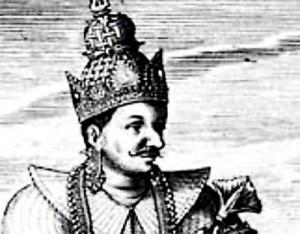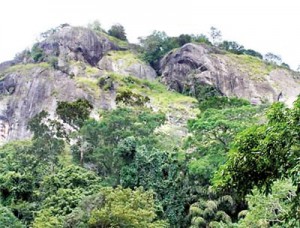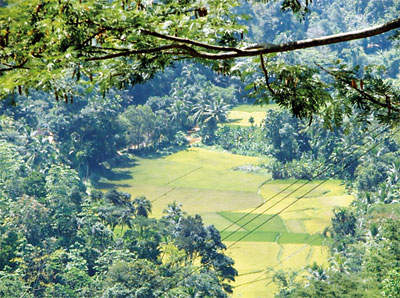The British invasion of 1815 – the march to Kandy
In early January 1815, nearly two centuries ago to the very year, armed columns set off from various parts of the coastline into the Kandyan territory to subject the interior kingdom –this time to British rule. History was very much on the march once again.
Sound planning had been the hallmark of this latest expedition according to Geoff Powell, author of the book ‘The Kandyan Wars’ whose knowledge of matters military is to be appreciated. However, the military precedents were scarcely of any encouragement to the British especially considering their own debacle in Kandy in 1803 and an abortive expedition in 1804. As if to remind the invading troops, they passed nearby if not right through, the sites of famous battles that had raged in the past.

King Wimaladharmasuriya I (www.rootsweb.ancestry.com)
At a short distance from the outskirts of Colombo lay Mulleriyawa – hardly a passing reference for this particular campaign but for the memories it held from some centuries ago. This is where the first Rajasinghe, still a young prince, fought a bloodthirsty battle in 1559 and then emerged in savage triumph after routing the invading Portuguese forces. Over the ensuing years he followed it up with a successful, if vicious, occupation of Kotte and later Kandy. In 1587 Rajasinghe once more pressed on to the western coast to besiege the fort at Colombo showing considerable prowess in the battlefield though he could not secure victory.
The British 1st Division under Major Hook had actually set out on December 9, 1814 first for Hanwella that was about an 18 mile march from the Colombo fort and then to Avissawella located about 12 miles from the Kandyan border in early January 1815. Interestingly, both Hanwella and Avissawella had tales of their own and any misgivings their troops may have experienced on this expedition could be readily understood.
Hanwella lay within the colonial boundary and was something of a bellwether in the first British invasion when it was garrisoned by British troops. Then, in August 1803 the Kandyan forces, jubilant in their victory over the British, fell upon this fortress. The fortress was retaken by British reinforcements only to have the Kandyan forces surging back in September. This time the amassed Kandyan troops were ambushed with British cannon fire through a thicket as they approached the fort on the plain. It was more a massacre than a battle according to Powell. So forceful was the ejection of the Kandyan troops that the king of Kandy was overtaken in retreat

The crags of Balana (www.lakdasun.org) and (left bottom) the valley below today (lk.worldmapz.com)
into his kingdom by the general in charge.
Avissawella was the site of defeat for an earlier Dutch army in 1764 that had entertained much the similar ambitions to the British when it rapidly marched 8,000 strong into the Kandyan kingdom. In retreat that same year, a much debilitated remnant of 400 Dutch soldiers was annihilated at this site, according to Marshall. A renewed attempt by the Dutch in 1765 to take Kandy met with a very similar fate with the major battle site this time being Hanwella instead. There was one particularly notable though indirect casualty from this encounter– the Dutch Governor Van Eck who took his own life after retreating from Kandy.
The experiences of the Dutch invading forces were not unprecedented and the explanation lay further interior on the Kandyan side of the border, in the mountainous terrain of the kingdom that beckoned the invaders to their fate. There lay the pass at Balana that bore a history of successful defence against occupiers both local and foreign. The sheer vantage points of the Balana mountain range that oversaw the pass leading to Kandy from the west gave credence to its name – to lookout. However, its scenic beauty with its verdant forest cover that endures to this day could easily justify another interpretation– to gaze.
Yet despite all the lush tranquility of Balana today, it was here in 1591 that the renegade occupant of the throne of Kandy, Konnappu Bandara defeated the forces of Rajasinghe I with finality ending Rajasinghe’s domination of Kandy. Konnappu Bandara’s worries were not over; by 1594 another major battle followed against the invading Portuguese forces. They were led by Manoel De Sousa who brought their candidate for the throne, the princess Kusumasana Devi, known better as Dona Catherina. Confronted at Balana not only with the hostile Kandyan forces but also strategically felled trees across their path and boulders that crashed down from the heights, the Portuguese army was routed by Konappu Bandara. Among the few survivors were Dona Catherina and her retinue.
There were at least two significant outcomes of this battle for posterity: first the victor, calling himself king Wimaladharmasuriya I, returned to Kandy having secured not only his kingdom but also the hand of Dona Catherina to be his queen. That union led to the dynasty that ruled Kandy till 1739. Second, the crags of Balana and the valley below began to acquire its reputation for defending the kingdom and dooming the invaders. In later centuries, the strategy changed somewhat with the Kandyans initially yielding their capital to their invaders. Encircled in the mountains of Kandy, the later invaders were systematically starved of supplies and often compelled to retreat fatefully via Balana. However, the romantic aspect of it was never to be repeated by the later kings.
By the second week of January of 1815, while the British 1st Division remained at Avissawella, Henry Marshall recorded the arrival of another prominent British civil servant from Colombo who may well be considered the colossus on which the entire British expedition’s success rested. And that was none other than John D’Oyly Esq. (later Sir John D’Oyly). A dedicated genius on his majesty’s civil service to some and a supremely devious character to others, D’Oyly’s capabilities in whichever respect are not to be understated. At all events, he had a persuasive manner that facilitated the advance of the British troops through the Kandyan territory.
Quite apart from tacitly taking the entire campaign into his hands, D’Oyly appeared to possess the key to the conquest that had so eluded previous invaders– a profound insight into the soul of the Kandyans, possibly enhanced by his fluency in Sinhala. He had a manner of evoking appeasement and consensus even when the Kandyan parties remained suspicious among themselves. Yet, there was a personally mystifying aura about him, cutting as he did a Sherlock Holmes- like contemplative, austere figure. A little more daylight would have been certainly preferred into his particular brand of mystique.
Whilst at Avissawella, an incursion of Kandyan provocateurs occurred nearby leading to the formal declaration of war on January 11, 1815. By January 28th, the 1st Division had crossed the Kandyan border and established itself at Ruwanwella. There D’Oyly penned a letter to Major Kelly leading the 3rd Division through the South East quarter of the kingdom- the Uva province.
D’Oyly advised Kelly that he could replenish his resources at Wellawaya. Though barely amounting to a journal entry in this campaign, yet it was at Wellawaya in 1630 that a youthful Rajasinghe II, then only a prince, confronted the Portuguese forces of Constantine De Saa. De Saa and his forces had occupied Kandy earlier and the royal household disappeared in flight this time into the mountains of the Uva province. De Saa, having reduced much of the countryside to ruin, pursued the king into Uva. There his army was obliterated in the encounter at Wellawaya and the grotesque trophy of his severed head was presented to the victorious prince.
By the end of January 1815, the 1st Division had advanced to Ganetenne approaching the foothills of the Balana range. On February 2nd, D’Oyly and a detachment of the 1st Division visited the nearby ancestral village of the Molligoda Adigar (chief minister). Succumbing to the charms of the countryside that he passed for the first time, D’Oyly noted in a letter to the Governor that “It is a beautiful Romantic Valley abounding in well cultivated Paddy fields & gardens.”
Later that day, D’Oyly added a most consequential postscript of this campaign, rejoicing that “the reputed Difficulties of the Balane Mountains have been surmounted with so much Facility” by a newly arrived column of the 2nd Division. Less than a week later, Governor Brownrigg arrived at Ganetenne with the remainder of the 2nd Division. Molligoda Adigar himself appeared at the camp on February 8th attended by a number of chiefs to surrender himself and the banners of his province. With that the Kandyan resistance to the British advance ended according to Powell.
On February 12th, 1815 D’Oyly with a small patrol, including the Governor’s son, arrived at Gannoruwa on the outskirts of Kandy. The ferry at Gannoruwa over the centuries was the usual staging post for emissaries waiting to cross the river, but that was not its only reputation. It was here in 1638 that Rajasinghe II had one more encounter with the Portuguese army led by Diego De Melo. Once again the invaders entered and occupied an abandoned capital till they were essentially strangled by siege and compelled to retreat. This was a landmark encounter because it was the last time that the Kandyan forces fought in pitched battle and a victorious Rajasinghe II pledged his crown to the nearby Dodamwela shrine in fulfilment of his vow for success in battle.
Now, nearly two centuries later, D’Oyly’s party found Gannoruwa deserted except for a morbid welcome given by nineteen impaled corpses at the site. A little later on, villagers began trickling in and informed that the king had fled and that Kandy was abandoned. For the Kandyans all this was a familiar part of the kingdom’s history. For the British, the expedition had gone so smoothly with no loss of life; their troops had lost more blood to leeches than any fighting. However, for both sides there yet remained unanswered, if history would repeat itself -and if not, for what reason then. The sites of battles that had raged in the past had stood mute in their testimony so far. For the time being, the road into Kandy stretched unopposed ahead.
This article traces a part of the British advance into the kingdom based mainly on the accounts of Henry Marshall’s ‘Ceylon: a General Description’, Codrington’s ‘Diary of Mr. John D’Oyly’ and Geoff Powell’s ‘The Kandyan Wars’ (both Marshall and D’Oyly, it is to be noted, were among the actual columns that marched in 1815).


